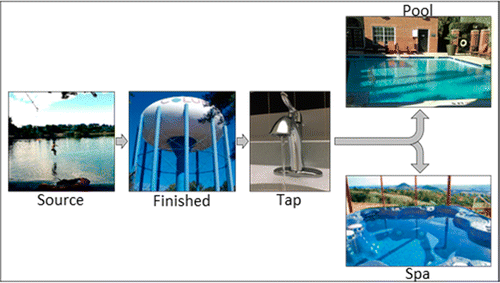Hot tubs and swimming pools are not as clean as you may think

Whether water is hot in a tub or cold in a pool, it can bring immediate relief from stress or summer heat. But hot tubs and swimming pools are not always as clean as you might think, even when disinfected. In a new study in ACS' Environmental Science & Technology, scientists have found that the more these facilities are used, the more potentially harmful compounds they contain.
Disinfectants such as chlorine kill pathogens in hot tubs and swimming pools, whether they are personal or public facilities. But disinfectants also react with sweat, urine and other substances that users add to the water. Studies of swimming pools have identified many of the resulting compounds, called disinfection byproducts. And testing has shown that they can cause genetic damage to cells in lab settings. Other reports have found that some people who swim or work in and around pools have higher rates of certain health problems, including respiratory symptoms and bladder cancer. Susan D. Richardson and colleagues took a closer look at hot tubs, in addition to pools, to help flesh out potential problems with disinfection byproducts.
The researchers sampled water from public and private hot tubs and pools from tap to basin, and after both normal and intense use. They identified more than 100 disinfection byproducts in the water and tested extracts of the samples for their potential to cause genetic damage to cells in the lab. On average, pool and hot tub samples were 2.4 and 4.1 times more mutagenic, respectively, than the original tap water used to fill them.
Heavy use increased mutagenic potencies further. But, the researchers say, pool and hot tub operators could reduce disinfection byproducts by cleaning facilities and changing water more frequently. In addition, they could encourage swimmers to shower before sliding in and to use toilets when needed.
More information: Eric J. Daiber et al. Progressive Increase in Disinfection Byproducts and Mutagenicity from Source to Tap to Swimming Pool and Spa Water: Impact of Human Inputs, Environmental Science & Technology (2016). DOI: 10.1021/acs.est.6b00808
Abstract
Pools and spas are enjoyed throughout the world for exercise and relaxation. However, there are no previous studies on mutagenicity of disinfected spa (hot tub) waters or comprehensive identification of disinfection byproducts (DBPs) formed in spas. Using 28 water samples from seven sites, we report the first integrated mutagenicity and comprehensive analytical chemistry of spas treated with chlorine, bromine, or ozone, along with pools treated with these same disinfectants. Gas chromatography (GC) with high-resolution mass spectrometry, membrane-introduction mass spectrometry, and GC-electron capture detection were used to comprehensively identify and quantify DBPs and other contaminants. Mutagenicity was assessed by the Salmonella mutagenicity assay. More than 100 DBPs were identified, including a new class of DBPs, bromoimidazoles. Organic extracts of brominated pool/spa waters were 1.8× more mutagenic than chlorinated ones; spa waters were 1.7× more mutagenic than pools. Pool and spa samples were 2.4 and 4.1× more mutagenic, respectively, than corresponding tap waters. The concentration of the sum of 21 DBPs measured quantitatively increased from finished to tap to pool to spa; and mutagenic potency increased from finished/tap to pools to spas. Mutagenic potencies of samples from a chlorinated site correlated best with brominated haloacetic acid concentrations (Br-HAAs) (r = 0.98) and nitrogen-containing DBPs (N-DBPs) (r = 0.97) and the least with Br-trihalomethanes (r = 0.29) and Br–N-DBPs (r = 0.04). The mutagenic potencies of samples from a brominated site correlated best (r = 0.82) with the concentrations of the nine HAAs, Br-HAAs, and Br-DBPs. Human use increased significantly the DBP concentrations and mutagenic potencies for most pools and spas. These data provide evidence that human precursors can increase mutagenic potencies of pools and spas and that this increase is associated with increased DBP concentrations.
Journal information: Environmental Science & Technology
Provided by American Chemical Society
















